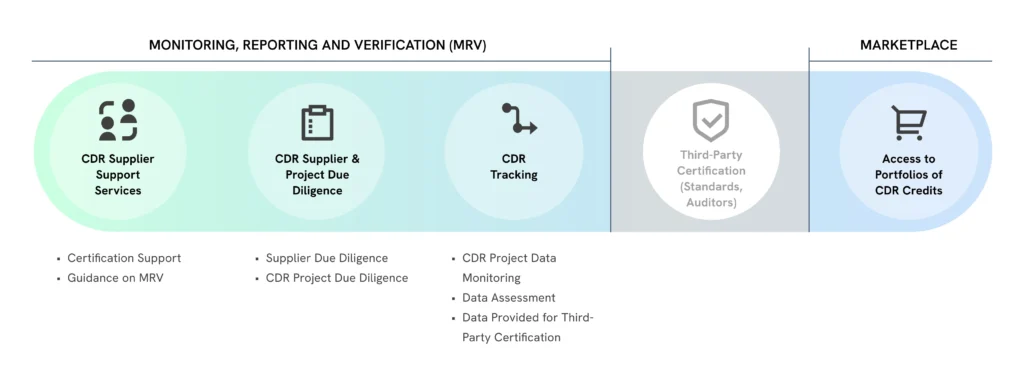Table of Contents
Decoding carbon transparency: What it means for your business
In our eco-conscious world, “carbon transparency” is more than just a buzzword – it’s a vital practice for businesses. But what does it really mean, and why should your organization care? Simply put, carbon transparency involves accurately measuring, reporting, and sharing your company’s carbon footprint—the total greenhouse gas emissions from your activities. By adopting carbon transparency, you gain a clear picture of your environmental impact. This insight helps you make smart decisions and develop strategies to reduce your carbon emissions. Not only does this align your business with sustainable practices, but it also boosts your credibility and reputation with customers, investors, and regulators.
The crucial role of carbon transparency in today’s world
As climate change continues to be a pressing global concern, consumers, investors, and governments are increasingly demanding accountability and action from businesses. Carbon transparency plays a pivotal role in addressing these demands by providing a clear picture of your organization’s environmental footprint.
- Meeting regulatory requirements: Many countries and regions have implemented regulations and reporting standards for carbon emissions, such as the Greenhouse Gas Protocol or the Carbon Disclosure Project. Adhering to these guidelines through carbon transparency ensures compliance and avoids potential penalties or reputational damage.
- Attracting environmentally conscious customers: Consumers are increasingly making purchasing decisions based on a company’s environmental responsibility. By transparently communicating your carbon footprint and mitigation efforts, you can appeal to this growing demographic and gain a competitive advantage.
- Enhancing investor confidence: Investors are increasingly factoring environmental, social, and governance (ESG) criteria into their decision-making processes. Carbon transparency demonstrates your commitment to sustainability, which can attract socially responsible investments and improve your overall financial performance.

Illustration of a comprehensive Monitoring, Reporting, and Verification (MRV) system. Source: Carbonfuture.
Sustainable success: How carbon transparency drives business practices
Embracing carbon transparency is not merely a compliance exercise; it can profoundly shape your business practices and drive sustainable growth. By accurately measuring and reporting your carbon emissions, you gain valuable insights into areas where improvements can be made, enabling you to implement targeted strategies for reducing your environmental impact.
Being transparent about your carbon footprint can highlight inefficiencies in your operations, like using too much energy, having wasteful processes, or running inefficient logistics. By tackling these issues, you can not only shrink your carbon footprint but also save money and boost your overall efficiency.
Chasing carbon transparency can actually drive innovation in your company. As you work to cut down emissions, you might discover new, eco-friendly technologies, materials, or processes. This journey can lead to creating innovative products or services that are better for the environment.
When you show a real commitment to carbon transparency and actively work to reduce your environmental impact, it can do wonders for your brand. People will see your business as responsible and sustainable, which can boost customer loyalty, keep your employees happy, and give you a competitive edge in the market.
Achieving carbon transparency: A step-by-step guide for businesses
Implementing carbon transparency in your organization may seem daunting, but it can be broken down into manageable steps. Here’s a step-by-step guide to help you achieve carbon transparency:
- Conduct a comprehensive carbon footprint assessment: The first step is to get a clear picture of your organization’s carbon emissions from all parts of your operations—energy use, transportation, waste, and supply chain activities. This assessment will give you a baseline for your carbon footprint and help you spot areas where you can improve.
- Develop a carbon reduction strategy: Using the insights from your carbon footprint assessment, create a solid plan to cut down your emissions. This could mean setting clear targets, adopting energy-efficient technologies, streamlining logistics, and working with suppliers to lower their carbon footprint too.
- Implement tracking and reporting mechanisms: Set up strong systems and processes to keep track of and report your carbon emissions regularly. This might mean investing in specialized software or teaming up with third-party providers to make sure your reporting is accurate and transparent.
- Communicate your efforts: Share your carbon footprint, reduction plans, and progress openly with your stakeholders. Use different channels like sustainability reports, website updates, and investor presentations. This shows your commitment to being environmentally responsible and helps build trust with your audience.
- Continuously improve and adapt: Carbon transparency is a continuous journey. Regularly review and tweak your strategies as regulations change, new technologies emerge, and industry best practices evolve. Always aim to improve and stay ahead in environmental responsibility
Essential tools and resources for carbon emission reporting
To effectively implement carbon transparency, you’ll need access to the right tools and resources. Here are some essential tools and resources to consider:
- Carbon accounting software: Specialized software platforms like Carbon Analytics, Greenhouse Gas Protocol, or CarbonView can help you accurately calculate, track, and report your carbon emissions.
- Industry-specific guidelines: Many industries have developed specific guidelines and methodologies for carbon accounting and reporting. Refer to resources from organizations like the World Resources Institute, the Environmental Protection Agency, or industry associations for sector-specific guidance.
- Third-party verification services: Engaging with independent third-party verifiers, such as CDP or SCS Global Services, can add credibility and transparency to your carbon reporting efforts.
- Sustainability consultants: Experienced consultants or firms specializing in sustainability and carbon management can provide valuable expertise and guidance throughout your carbon transparency journey.
Success Stories
Numerous businesses across various industries have embraced carbon transparency and reaped the benefits of responsible business practices. Here are a few inspiring success stories:
- Patagonia: The outdoor clothing company has been a pioneer in environmental responsibility. They have implemented rigorous carbon accounting and reporting practices, setting ambitious targets to reduce their emissions across their supply chain. Their transparency and commitment have earned them a loyal customer base and a reputation as a sustainability leader.
- Microsoft: The tech giant has made carbon transparency a core part of its environmental strategy. They have been carbon neutral since 2012 and aim to be carbon negative by 2030. Microsoft’s comprehensive carbon accounting and reporting have not only reduced their environmental impact but also driven innovation in areas like energy-efficient data centers and sustainable cloud computing solutions.
- Unilever: The consumer goods company has made significant strides in carbon transparency, reporting their emissions across their entire value chain. Their efforts have led to substantial reductions in greenhouse gas emissions, water usage, and waste generation, while also driving product innovation and improving operational efficiency.
How carbon transparency influences buying decisions
In today’s eco-conscious market, carbon transparency plays a big role in shaping consumer choices. More and more, especially among millennials and Gen Z, people are looking for products and services from companies that prioritize sustainability and environmental responsibility. When you openly share your carbon footprint and efforts to reduce it, you show honesty and accountability. This transparency builds trust with consumers, which can lead to brand loyalty and a competitive edge in the market. Many consumers want their purchases to reflect their personal values and beliefs. By highlighting your commitment to carbon transparency and environmental responsibility, you attract these value-driven consumers who are eager to support brands that share their principles.
Companies that embrace carbon transparency are often seen as more innovative, forward-thinking, and committed to quality. This perception can sway buying decisions, as consumers may associate these traits with superior products or services. To make the most of carbon transparency in influencing buying decisions, it’s crucial to communicate your efforts through various channels like product labels, marketing campaigns, and social media. By making your environmental commitments clear and accessible, you can connect with conscious consumers and stand out in the market.
Addressing challenges and barriers in carbon transparency
While the benefits of carbon transparency are numerous, implementing it can present several challenges and barriers. Here are some common obstacles and strategies to address them:
- Data collection and accuracy: Gathering accurate and comprehensive data on carbon emissions across your entire operations and supply chain can be complex and time-consuming. Investing in robust data collection systems, partnering with suppliers, and leveraging technology solutions can help overcome this challenge.
- Cost and resource constraints: Implementing carbon transparency initiatives can involve significant upfront costs and require dedicated resources. However, these investments often yield long-term cost savings through improved operational efficiency and reduced environmental liabilities. Prioritizing carbon transparency as a strategic initiative and seeking external funding or partnerships can help mitigate resource constraints.
- Organizational resistance and cultural barriers: Embracing carbon transparency may require a cultural shift within your organization, which can face resistance from employees or stakeholders. Effective communication, training, and incentives can help overcome this resistance and foster a culture of sustainability.
- Lack of standardization and regulation: Inconsistent reporting standards and regulations across different regions or industries can create challenges in accurately measuring and comparing carbon footprints. Engaging with industry associations, regulatory bodies, and international organizations can help drive standardization and facilitate more consistent reporting practices.
By proactively addressing these challenges and barriers, you can effectively navigate the path towards carbon transparency and reap the benefits of responsible business practices.
The future of carbon transparency in business
As the world becomes more focused on sustainability, carbon transparency is set to become a crucial part of business operations. Governments and regulatory bodies are likely to enforce stricter carbon reporting requirements and emissions targets, making it essential for businesses to comply. The rise of digital technologies like IoT, AI, and blockchain will transform how we account for and report carbon emissions, with real-time data collection and automated tracking becoming standard practice. As the need to address climate change grows, businesses will be expected to aim for carbon neutrality or even negative emissions through advanced technologies.
Stakeholders, including investors, customers, and employees, will continue to demand clear evidence of environmental commitments. To support this, we might see more industry-wide initiatives and global frameworks for carbon reporting. By embracing these trends and making carbon transparency a strategic priority, businesses can lead in environmental responsibility, gain a competitive edge, and help create a sustainable future. Start your journey towards carbon transparency with our comprehensive solutions. Our experts will guide you through every step, from assessing your carbon footprint to setting up effective tracking and reporting systems. Enjoy the benefits of responsible business practices and stay ahead in environmental responsibility. Contact us today to begin your path to a sustainable future.
Literature
- Mandatory Corporate Carbon Disclosures and the Path to Net Zero: https://corpgov.law.harvard.edu/2021/11/08/mandatory-corporate-carbon-disclosures-and-the-path-to-net-zero/
- Transparency and Accountability on the Path to Net-Zero: https://www.uni-mannheim.de/media/Einrichtungen/mises/Dokumente/20230106_-_TransparencyJan23.pdf
- Green Business Is Good Business: Why Transparency Is Key For Corporate Sustainability: https://www.forbes.com/councils/forbesbusinesscouncil/2021/02/11/green-business-is-good-business-why-transparency-is-key-for-corporate-sustainability/
- Carbon reporting: A guide to responsibility and transparency: https://www.burnesspaull.com/insights-and-events/news/carbon-reporting-a-guide-to-responsibility-and-transparency
- Carbon: reducing emissions, demonstrating transparency: https://certification.bureauveritas.com/newsroom/carbon-reducing-emissions-demonstrating-transparency



